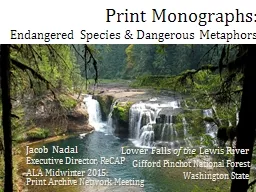

Jacob Nadal Executive Director ReCAP ALA Midwinter 2015 Print Archive Network Meeting Lower Falls of the Lewis River Gifford Pinchot National Forest Washington State Print Monographs ID: 650832
Download Presentation The PPT/PDF document "Print Monographs: Endangered Species &..." is the property of its rightful owner. Permission is granted to download and print the materials on this web site for personal, non-commercial use only, and to display it on your personal computer provided you do not modify the materials and that you retain all copyright notices contained in the materials. By downloading content from our website, you accept the terms of this agreement.
Slide1
Print Monographs:
Endangered Species & Dangerous Metaphors
Jacob NadalExecutive Director, ReCAPALA Midwinter 2015:Print Archive Network Meeting
Lower Falls
of the
Lewis River
Gifford Pinchot National Forest
Washington StateSlide2
Print Monographs:
Endangered Species & Dangerous Metaphors
The Map
Trends, rates,
inflection
points
Rule-proving
versus game-changing exceptions
The Trail
IUCN Red List
A risk-model for booksSlide3
Mid-20
th
CenturySlide4Slide5
This is a big opportunity
This can be addressed in
many ways and at
m
any ratesSlide6
Establish categories of concern
Archiving cycles for most likely high-impact mono groups
FRBRize
retention commitments
Consider hybrid (light/dim/dark) archives
Seek additional copies
Secondary market
Private collections
Non-PAN affiliated libs.
Rate of Change
Loss rate for ILL
Region/Consortia
Total Population
Extinct in the Library
(We may be more like the zoo than the wild)Slide7
Establish categories of concern
Archiving cycles for most likely high-impact mono groups
FRBRize
retention commitments
Consider hybrid (light/dim/dark) archives
Seek additional copies
Secondary market
Private collections
Non-PAN affiliated libs.
Rate of Change
Loss rate for ILL
Region/Consortia
Total Population
Extinct in the Library
(We may be more like the zoo than the wild)Slide8
Consider the Antelope…*
Dramatization
Twenty-five endangered antelope speciesLoss of habitat
Trophy hunting
Illicit pelt and horn trade
Competition with grazing cattle
De-escalation
“Wastebasket Taxon”
66 of 91 species are in “least concern” status (
72.5
%)
Systematic risk is low; individual risk is real and often very severe
Species risk and habitat loss may be better addressed as a joint issue, to preserve the creature and the place
Specifically, the Mountain
nyala
or
balbok
(
Tragelaphus
buxtoni
)
* With apologies to Suzanne
Briet and David Foster Wallace
Most artifact value falls in a small part of the longest part of the tail; keep specific instances
Assumptions about care give way to specific, binding, measurable commitments
Make room for technologies and workspaces…
… and also cultivate more
browsable
stacks and better curated collections
Localization
Andy
Stauffer:booktraces.org
(& forthcoming CLIR study)
MLA:
printrecord.commons
.
mla.org
SHARP: www.sharpweb.org
CLIR
: coherence.clir.org
OCLC: oclc.org/research/
activities/usl.html
CRL-PAN: crl.edu/
archiving-preservation/ print-archives
TriangulationSlide9
Thank you.Jacob Nadal
Executive Director, ReCAP:
The Research Collections & Preservation Consortiumjnadal@princeton.eduScarcity Case-study : jacobnadal.com/162
Image
Credits:
Alex
Dunke
,
FluttershyIsMagic
,
Николай Усик,
KrisMaes
, Lyn
Topinka
, Medicaster40,
Mulmatsherm. Petrarch1603
, pfly, US Forest Service, and US Geological
Serive.
All images sourced from the author, US government web sites, or from wikimedia.org, where they were posted under Creative Commons 2.0 or higher
.